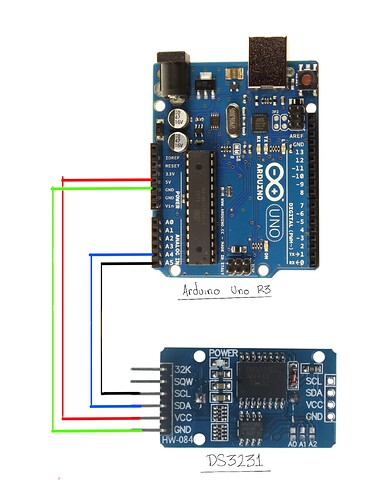Hello again!
So taking this step by step, I'm trying to get the time in the serial monitor to make sure that part is correct since everything else will be built on this. This code, when run, displays this in the serial monitor:
09:56:30.035 ->
09:56:30.035 -> C:\Users\bryan\Ap
09:56:30.035 -> al\Temp\.arduinoIDE-unsaved202376-3680-gw8g0r.uhv8s\SetSerial\SetSerial.ino
09:56:30.035 -> Aug 6 2023 09:56:25
09:56:30.035 -> RTC Sync
09:56:30.035 -> 31Dec2095 00:03:53
09:56:31.593 -> ,����n�>��ɗ�֙���@*����,��8҉����,���������8҉
this is the code I'm currently running:
// Arduino DS3232RTC Library
// https://github.com/JChristensen/DS3232RTC
// Copyright (C) 2018 by Jack Christensen and licensed under
// GNU GPL v3.0, https://www.gnu.org/licenses/gpl.html
//
// Example sketch to display the date and time from a DS3231
// or DS3232 RTC every second. Display the temperature once per
// minute. (The DS3231 does a temperature conversion once every
// 64 seconds. This is also the default for the DS3232.)
//
// Set the date and time by entering the following on the Arduino
// serial monitor:
// year,month,day,hour,minute,second,
//
// Where
// year can be two or four digits,
// month is 1-12,
// day is 1-31,
// hour is 0-23, and
// minute and second are 0-59.
//
// Entering the final comma delimiter (after "second") will avoid a
// one-second timeout and will allow the RTC to be set more accurately.
//
// No validity checking is done, invalid values or incomplete syntax
// in the input will result in an incorrect RTC setting.
//
// Jack Christensen 08Aug2013
#include <DS3232RTC.h> // https://github.com/JChristensen/DS3232RTC
#include <Streaming.h> // https://github.com/janelia-arduino/Streaming
#include <TimeLib.h>
DS3232RTC myRTC;
void setup()
{
Serial.begin(115200);
Serial << F( "\n" __FILE__ "\n" __DATE__ " " __TIME__ "\n" );
myRTC.begin();
// setSyncProvider() causes the Time library to synchronize with the
// external RTC by calling RTC.get() every five minutes by default.
setSyncProvider(myRTC.get);
Serial << F("RTC Sync");
if (timeStatus() != timeSet) Serial << F(" FAIL!");
Serial << endl;
}
void loop()
{
static time_t tLast;
time_t t;
tmElements_t tm;
// check for input to set the RTC, minimum length is 12, i.e. yy,m,d,h,m,s
if (Serial.available() >= 12) {
// note that the tmElements_t Year member is an offset from 1970,
// but the RTC wants the last two digits of the calendar year.
// use the convenience macros from the Time Library to do the conversions.
int y = Serial.parseInt();
if (y >= 100 && y < 1000)
Serial << F("Error: Year must be two digits or four digits!") << endl;
else {
if (y >= 1000)
tm.Year = CalendarYrToTm(y);
else // (y < 100)
tm.Year = y2kYearToTm(y);
tm.Month = Serial.parseInt();
tm.Day = Serial.parseInt();
tm.Hour = Serial.parseInt();
tm.Minute = Serial.parseInt();
tm.Second = Serial.parseInt();
t = makeTime(tm);
myRTC.set(t); // use the time_t value to ensure correct weekday is set
setTime(t);
Serial << F("RTC set to: ");
printDateTime(t);
Serial << endl;
// dump any extraneous input
while (Serial.available() > 0) Serial.read();
}
}
t = now();
if (t != tLast) {
tLast = t;
printDateTime(t);
if (second(t) == 0) {
float c = myRTC.temperature() / 4.;
float f = c * 9. / 5. + 32.;
Serial << F(" ") << c << F(" C ") << f << F(" F");
}
Serial << endl;
}
}
// print date and time to Serial
void printDateTime(time_t t)
{
printDate(t);
Serial << ' ';
printTime(t);
}
// print time to Serial
void printTime(time_t t)
{
printI00(hour(t), ':');
printI00(minute(t), ':');
printI00(second(t), ' ');
}
// print date to Serial
void printDate(time_t t)
{
printI00(day(t), 0);
Serial << monthShortStr(month(t)) << _DEC(year(t));
}
// Print an integer in "00" format (with leading zero),
// followed by a delimiter character to Serial.
// Input value assumed to be between 0 and 99.
void printI00(int val, char delim)
{
if (val < 10) Serial << '0';
Serial << _DEC(val);
if (delim > 0) Serial << delim;
return;
}
I entered the time in the serial monitor message bar according to the parameters laid out in the opening comments (at the time, it was 2023,8,6,09,56,30)
I'm expecting the time code to update every second on the serial monitor. Why am I getting just these initial ones with characters it wont recognize?

